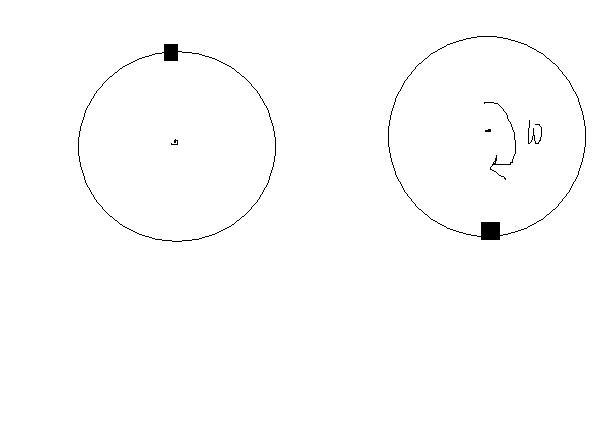Abhishek my problem is that in the first method you gave , why we have taken the angular velocity of mass M and the disc to be same
a disc of mass M and radius R, lying in the vertical plane is free to rotate about a horizontal axis passing through its centre . a body of mass M is fixed at the highest point of the disc Now the system is released When the body comes to the lowest position then its angular speed will be??
please give solution
-
UP 0 DOWN 0 1 6

6 Answers
☼◙◘☼◙◘☼◙◘☼◙◘☼◙◘☼◙◘☼◙◘☼◙◘☼◙◘☼◙◘☼◙◘☼◙◘☼◙◘☼◙◘

Mg(2R)=(1/2)(MR2/2)ω2+(1/2)M(ωR)2
solving this we get
ω28g/3R
ω=√8g/3R
_________________________________________
Or You can find moment of inertia of system about hinge and then apply (1/2)Ipω2
Ip=(MR2/2+MR2) = 3MR2/2
then Mg(2R)=(1/2)Ipω2
2MgR=3/4MR2ω2
ω=√8g/3R
☼◙◘☼◙◘☼◙◘☼◙◘☼◙◘☼◙◘☼◙◘☼◙◘☼◙◘☼◙◘☼◙◘☼◙◘☼◙◘☼◙◘
if ω is angular speed of disc then velocity of any particle on its circumference..(mass M is also there..) is ωR..
please can you explain giving some example or some concept that why the angular velocities are same
Consider a disc rotating with ang speed ω about com.. vith vcom=0
velocity of a particle at a distance R/2 from center is............
velocity of a particle at a distance R from center is............
or consider a rod rotating with ang speed ω then speed of particle halfway the rod is....... (if rod of length l is hinged at one end...)
If U know answers to these u know the one u asked...